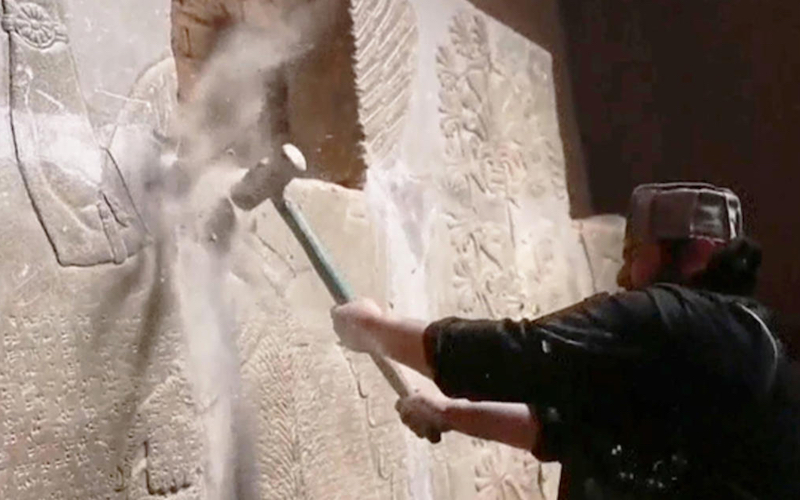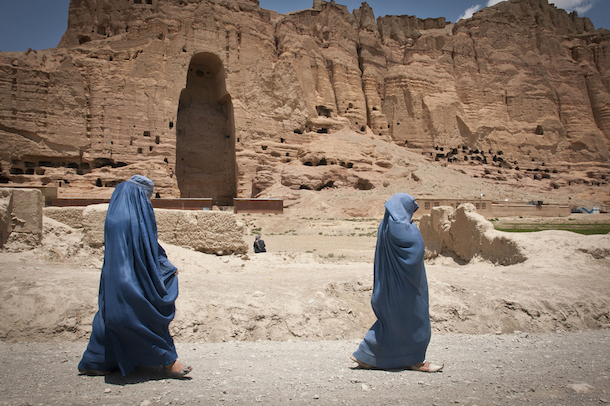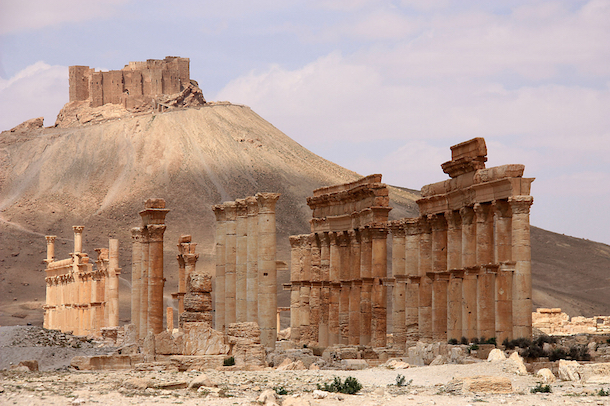
The Treasures Long-Lost
The destruction of pre-historic monuments and the plundering of historical artefacts has exposed the dark side of mankind over the centuries. Dating as far as 700 BC, Assyrian invaders destroyed and plundered temples in Babylon. The Taliban destroyed the Buddhist statues in Afghanistan and dozens of monuments and historical sites were demolished in Syria. The ongoing conflict in Syria again illustrates man’s propensity toward violence and destruction.
The destruction comes as a result of intense fighting reinforced by actions which are committed under the influence of a misguided ideology or for profit. When forces plunder, destroy historical monuments or steal artifacts they do so because their leaders do not consider the artifacts or monuments worthy of any value or relevant to their ideology. Furthermore, they fear the message or historical significance that the monument or artifact conveys. Historians define “monuments and historical artifacts” as having exceptional value, in accordance with the history of the state or a region. However, historians do add the word “importance.”
Thus, it is impossible for us to establish the definition with certainty of a cultural artifact or monument, because its “importance” relates to its specific inheritance. However, destruction of cultural heritage continues, especially in the Middle East, which has been condemned by many. To those who have an empirical knowledge of art, culture, history, the destruction of monuments and cultural artifacts, are an irreparable loss.
Not long ago, the UN Secretary General called the destruction of monuments “war crimes.” So, the question we are faced with is, how far will war consume history? How will we survive the destruction of our history? When will it end?
This is not the first time that our history has been threatened by war and conflicts. War and conflicts have continued to consume historical monuments and destroyed key cultural artifacts that the new generation will never experience, except perhaps in history books. Today, the destruction of such historical evidences has been threatened more frequently than ever before, posing a grave threat to many cultures and in some instances, our existence.
Chinese cultural revolution under Mao Zedong
The Chinese cultural movement began under the leadership of the then Chinese Primer Mao Zedong in 1966 finally ending in 1976.
The objective of the revolution was to preserve the “true” communist ideology by destroying all what remained of the capitalist’s elements in the Chinese society. However, the government at that time, had an official policy to protect ancient monuments and cultural artefacts and architecture of historical importance, but the policy was never implemented.
Of over 6,483 registered sites which were protected by the Chinese government, more than 4,922 were destroyed during the revolution. Reports however estimated that the destruction of historical monuments and cultural artifacts were much higher. Although, there were no reports as to how many monuments were plundered or the exact number of artifacts destroyed or smuggled out of the country, many historians believe that the number of monuments destroyed were larger than what was estimated. However, the government did not openly advocate the plunders, but it did not take a swift action, so the plunderers remain unchallenged and they continued to destroy the historical evidence of their own past.
The destruction of the Bamiyan Buddhas by Taliban
The Bamiyan Valley, which now is the Central Afghanistan, was host to two massive Buddha statues which historians believed to have been built in the early 6th Century BC. These statues were designated as a UNESCO world heritage site. One statue stood at 55 meters tall while the other stood at around 37 meters. As soon as the Taliban took control, the Taliban leader, Mullah Mohammed Omar, initiated an order to destroy these statues, which were subsequently destroyed.

With their enormous size, it took the Taliban over 25 days to destroy the Buddhas. They used high explosive ordinances including TNT explosions, until they were reduced to rubble. The statues were destroyed because they signified idol worship in Buddhism, which was opposed by the Taliban, as the statues were not only idols, they were in the form of humans. According to the Taliban, not only creating art in the form of humans or animals was prohibited but all kinds of art was prohibited. The site was once a tourist attraction, and its destruction created a huge outcry.
Destruction of monuments and artifacts by ISIS
ISIS has been destroying lives in and around Iraq and Syria and recreating the historical boundaries of what we knew once as sovereign countries. ISIS is also responsible for the destruction of treasured historical landmarks, artifacts and monuments. The destruction began in February 2015, when they looted and destroyed the Mosul Museum in Mosul, Iraq. A video released by a prominent ISIS supporter on twitter showed the rampant looting by ISIS militants in the museum and the destruction of artefacts, historical pieces dating back more than six thousand years and finally destroying the museum. Historians described the Mosul museum as a “crest of history” where documents could be found that led to the creation of Macedonia and pre-Macedonia.
Their actions were rampant, indiscriminate and sent a clear message to the West, “Syria, will never be the same again.” From what was seen in the video, historical artifacts and antiquities from two of four rooms were looted, the fate of the rest is unknown. Host of the most valuable treasures of the East, the Islamic Hall was turned to ashes. Moreover, the ISIS militants burned artefacts which were too large to carry or too large to transport. In addition to the rampant looting of the artifacts, the quantities of those artifacts remains unknown, which has increased the possibility of their having been sold in the black market.

Besides historical artifacts of religious and cultural importance, ISIS destroyed monuments and castles dating back to the first centuries. ISIS, after taking control over Palmyra, one of the oldest cities in Syria, which historians believe dated back to the first and second centuries, plundered and destroyed more historical evidence. This city, which was a UNESCO world heritage site, a crossroads of trade where the kings and the pharaohs traded with the Greeks, Romans, Persians along with the locals. It contained many castles and monuments of religious and cultural importance, which ISIS considered to be a violation of their interpretation of Islam.
After heavy plundering and destruction of key monuments by Daesh fighters, the city was subjected to massive aerial raids and attacks which claimed the lives of many and destroyed the houses of residents, schools and ancient ruins. UNHCR and UNESCO openly condemned the aerial attacks on civilians which, although did destroy Daesh fighters staging areas, also permanently eliminated the cities historical importance.
ISIS then destroyed two important mausoleums in Palmyra which were located in areas outside the ideology of the Daesh: one on the resting place of a famous Sufi scholar and the other was on a Shiite Muslim philosopher and saint. Additionally, ISIS is single handily responsible for the destruction of many historical monuments and other artifacts of great significance to religion and culture. Many historical sites have also been destroyed due to suicide bombings and the intense fighting that took place between the anti-ISIS coalition and Daesh.
The Causes
There are three main reasons responsible for the destruction of monuments and artifacts: religious fundamentalist ideology, market value, money and profit and casualties generated by the war. Let us try to understand these causes.
Religious fundamentalist ideology is a primary instigator and one of the main reasons for the destruction of cultural artifacts. It is the primary driving force for the two other causes. Each of them is influenced by ideology. However, actors, situations and timelines vary. The Chinese communists destroyed the monuments and key essential artifacts because they represented anti-communism; the Taliban along with Daesh, destroyed antiquties because they belonged to a ruler or portrayed a human image, which violated their ideology. The ideological difference and misconceptions about the historical valued items comes from their fear of what the monument or artifacts symbolized. By simply destroying such symbols, they feel they are destroying the symbols which hold power and thus they are destroying the power.
Propaganda is one of the motivating factors of the militant organizations. An example is the destruction of Mosul Museum by Daesh fighters. Post-destruction propaganda was used by Daesh fighters when they posted the video to celebrate their act and they wanted to let the entire world to know, propaganda remains an essential part of Daesh’ ideology, so, by making and sharing the video with the world, they accomplished two key goals.
Market, money and profit are other incentives. As mentioned above, Daesh fighters looted most of the artifacts from Mosul and left those which they couldn’t carry which were sold in the black market. Selling artifacts in the black market was one out of three ways Daesh could generate money. ISIS also financed war by selling artifacts.
War also causes the destruction of key monuments and historical sites.
Conclusion
The way to end further destruction of monuments and artifacts, is to permanently end conflict. There are a few measures which we can take to prevent further destruction of antiquities.
We can start by first preserving the artifacts. This can be achieved by moving the artifacts away from hostile zones, but it’s not suggested by historians, as the artifact may lose its cultural significance with respect to the region or its place of origin. Another way to preserve artifacts is though digitization by partnering with many private digital libraries. However, the physical preservation of the artifact would still not come under the umbrella of “safety from destruction” and could remain vulnerable, but it may prove to be a possible alternative.
By involving international organizations such as the UN countries can put an end to the raging piracy and black marketing of artifacts.
However, the only way to avoid destruction is to end the conflict permanently and bring political stability to the region. While discussing the safety of artifacts within the context of saving lives, the latter always outweighs the former. Therefore, artifacts will always be vulnerable and prone to destruction during conflicts. Through history we have learned that few measures have ever prevented a conflict from happening, leaving the vast rich cultural artifacts to their own fate.

